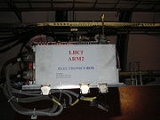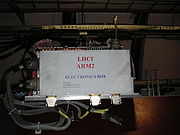
LHCf
Encyclopedia

Large Hadron Collider
The Large Hadron Collider is the world's largest and highest-energy particle accelerator. It is expected to address some of the most fundamental questions of physics, advancing the understanding of the deepest laws of nature....
experiment for astroparticle (cosmic ray
Cosmic ray
Cosmic rays are energetic charged subatomic particles, originating from outer space. They may produce secondary particles that penetrate the Earth's atmosphere and surface. The term ray is historical as cosmic rays were thought to be electromagnetic radiation...
) physics, and one of seven detectors in the LHC accelerator at CERN
CERN
The European Organization for Nuclear Research , known as CERN , is an international organization whose purpose is to operate the world's largest particle physics laboratory, which is situated in the northwest suburbs of Geneva on the Franco–Swiss border...
. The other six are: ATLAS
ATLAS experiment
ATLAS is one of the six particle detector experiments constructed at the Large Hadron Collider , a new particle accelerator at the European Organization for Nuclear Research in Switzerland...
, ALICE
A Large Ion Collider Experiment
ALICE is one of the six detector experiments at the Large Hadron Collider at CERN. The other five are: ATLAS, CMS, TOTEM, LHCb, and LHCf. ALICE is optimized to study heavy ion collisions. Pb-Pb nuclei collisions will be studied at a centre of mass energy of 2.76 TeV per nucleon...
, CMS
Compact Muon Solenoid
The Compact Muon Solenoid experiment is one of two large general-purpose particle physics detectors built on the proton-proton Large Hadron Collider at CERN in Switzerland and France. Approximately 3,600 people from 183 scientific institutes, representing 38 countries form the CMS collaboration...
, MoEDAL
MoEDAL experiment
The Monopole and Exotics Detector At the LHC is an international research collaboration whose spokesperson is the University of Alberta’s James Pinfold. MoEDAL is the seventh experiment at the LHC; it was approved and sanctioned by the CERN research board on May of 2010, and started its first test...
, TOTEM
TOTEM
TOTal Elastic and diffractive cross section Measurement is one of the six detector experiments at the Large Hadron Collider at CERN. The other five are: ATLAS, ALICE, CMS, LHCb, and LHCf. It shares intersection point IP5 with the Compact Muon Solenoid...
, and LHCb
LHCb
LHCb is one of six particle physics detector experiments collecting data at the Large Hadron Collider accelerator at CERN. LHCb is a specialized b-physics experiment, that is measuring the parameters of CP violation in the interactions of b-hadrons...
. LHCf is designed to study the particles generated in the "forward" region of collisions, those almost directly in line with the colliding proton beams. It therefore consists of two detectors, 140 m on either side of the interaction point.
Because of this large distance, it can co-exist with a more conventional detector surrounding the interaction point, and shares the interaction point IP1 with the much larger general-purpose ATLAS experiment
ATLAS experiment
ATLAS is one of the six particle detector experiments constructed at the Large Hadron Collider , a new particle accelerator at the European Organization for Nuclear Research in Switzerland...
.
Purpose
The LHCf is intended to measure the energy and numbers of neutral pions produced by the collider. This will hopefully help explain the origin of ultra-high-energy cosmic rayUltra-high-energy cosmic ray
In astroparticle physics, an ultra-high-energy cosmic ray or extreme-energy cosmic ray is a cosmic ray with an extreme kinetic energy, far beyond both its rest mass and energies typical of other cosmic rays....
s. The results will complement other high-energy cosmic ray measurements from the Pierre Auger Observatory
Pierre Auger Observatory
The Pierre Auger Observatory is an international cosmic ray observatory designed to detect ultra-high-energy cosmic rays: single sub-atomic particles with energies beyond 1020 eV...
in Argentina, and the Telescope Array in Utah.

